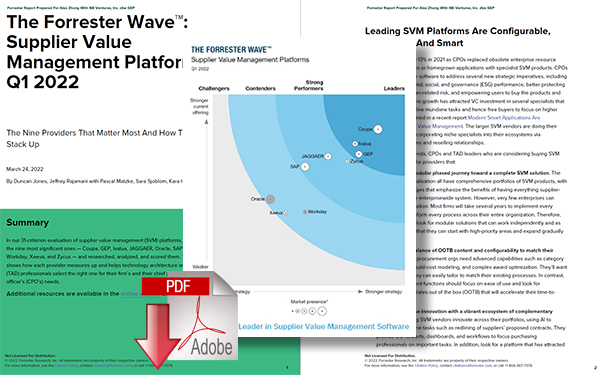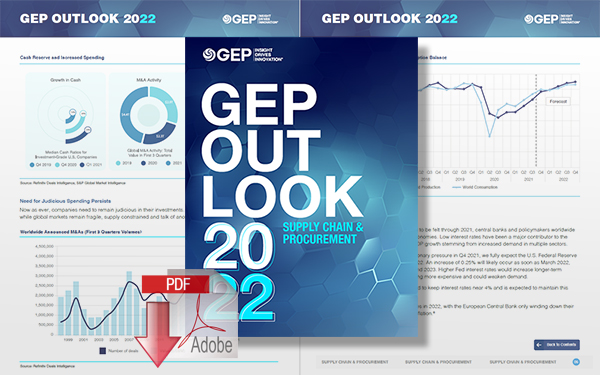4 Strategic Reasons to Choose a Unified Source-to-Pay Platform Over Enterprise Resource Planning

Enterprise resource planning systems have not provided the needed clarity and, in some respects, have made problems worse, as they don’t readily allow for the necessary rapid response to massive upheavals caused by disruption.
Supply Chain and Procurement Operations
Supply chain and procurement operations are always evolving, and businesses are in a constant race to keep up with changing marketplace conditions, shifts in consumer demand, and advances in technology.
To do so, they remain on the lookout for the next innovation that will enable them to reshape their supply chain and procurement operations while jumping ahead of the competition.
For the last several decades, innovation has come in the form of large-scale digital transformation. Along these lines, enterprises have invested billions of dollars in enterprise resource planning (ERP) systems to achieve efficiency and cost reductions.
These systems should have helped, or at least provided a foundation to help, organizations handle the spate of recent disruptions and manage the resulting uncertainty.
However, ERPs have not provided the needed clarity and, in some respects, have made problems worse, as they don’t readily allow for the necessary rapid response to massive upheavals caused by disruption.
These systems also try to take a one-size-fits-all approach, requiring organizations to fit their needs to existing functionality.
Enterprises that rely on ERPs now face several critical issues in operating their source-to-pay (S2P) functions effectively.
First, they don’t have good visibility into or control of their S2P processes, leading to higher costs.
Second, ERPs reduce cohesion in procurement functions by creating silos and barriers to workflow, causing inefficiencies.
What’s the best way forward for organizations facing these obstacles?
The Modern Platform
To bridge the gaps between source-to-contract (S2C) and procure-to-pay (P2P) functions that ERPs create, enterprises should use an innovative and modern end-to-end S2P solution outside of their ERP.
Using such a unified digital ecosystem breaks down the barriers between functions for seamless workflow and analytics, fostering cohesiveness and efficiency. Along with bridging the gap between supply chain execution and planning, a modern platform integrates with sourcing and procurement to connect data, processes, and partners across the entire supply chain network.
What can an enterprise look to gain from a modern platform?
Enhanced Efficiency and Reduced Costs
Connecting S2P processes in an end-to-end system ensures a seamless flow of data, information, and capital.
This cohesiveness enables businesses to:
- Continuously cut costs and improve productivity
- Manage risk and build more resilient supply chains
- Maximize the value from their partner network and business ecosystem
- Reduce cycle time in introducing new products and speed up time to market
- Improve service and product qualities to serve customers better
- Drive innovation and growth for their enterprise
When taken together, these features encourage efficiency by removing unnecessary barriers and breaking down silos, thereby reducing costs.
Enhanced visibility
On an open and unified platform, organizations can gain real-time visibility into end-to-end sourcing and procurement and supply chain processes such as inventory management, capacity planning, and purchase orders as well as into suppliers, logistics providers, and trading partners. It enables visibility into all that data via a single source of truth, making data collection, processing, and analysis more effective. This provides a foundation for building resilience in the supply chain, mitigating against risk, collaborating with partners, and handling disruptions with greater flexibility.
Developmental Agility and User Experience
ERPs are not nimble. A modern unified platform that is built on low-code/no-code architecture, however, provides organizations with the developmental flexibility and agility to address changes in the business environment as they arise. Users are able to develop applications that address specific needs. Furthermore, the platform offers users the potential to test and iterate functionality, add or subtract capabilities, incorporate input from users and stakeholders, and adjust as needed.
Low-code/no-code architecture also allows for an intuitive, user-centric design that requires minimal training up front and leads to quick user adoption, saving time and money. In addition, the user can engage with and manipulate information without having to change anything on the back end, eliminating manual workarounds to overcome ERP deficiencies as well as alleviating IT resource time.
Better Compliance
An easy-to-use, intuitive user interface drives adoption; in procurement, adoption drives compliance, which leads to greater savings. With technology that works seamlessly and treats each aspect of procurement and supply chain as an interconnected whole, organizations can more effectively stay on top of global compliance issues to mitigate risk as well as to inspect and track quality.
Bottom Line
To effectively respond to disruption and manage uncertainty, organizations need to implement a modern unified platform that provides a holistic, innovative, and flexible S2P experience; this helps gain greater visibility and break down silos. Breaking procurement out of the ERP cage enables enterprises to leverage a best-in-class global solution.
Related Resources
The Forrester Wave™: Supplier Value Management Platforms, Q1 2022
In this Forrester Wave™ report, we take a deep dive into a 31-criterion evaluation of supplier value management platforms, we identified the nine most significant ones - Coupa, GEP, Ivalua, JAGGAER, Oracle, SAP Ariba, Workday, Xeeva, and Zycus - and researched, analyzed, and scored them. Download Now!
GEP Outlook 2022 - Supply Chain & Procurement: Key Trends, Challenges, and Opportunities
Get actionable insights to effectively deal with disruption and uncertainty and learn supply chain and procurement strategies that can help your business thrive in the new normal. Download Now!
More Resources from GEP
Related Article: 10 Tips for Vetting Software Vendors Through the ERP Software Selection Process
Article Topics
GEP News & Resources
GEP Procurement & Supply Chain Tech Trends Report 2024 How Procurment and Supply Chain Leaders Should Handle Supply Chain Disruptions Optimizing Business Outcomes by Investing in Sustainable Supply Chains and Procurement Optimizing Direct Material Sourcing with a Unified, Extensible Source-to-Pay Platform Generative AI in Procurement Navigating the Cost-Plus World of Supply Chains How to Avoid the Pittfalls of Contract Management in Telecom and High-Tech More GEPLatest in Supply Chain
Baltimore Bridge Collapse: Impact on Freight Navigating TIm Cook Says Apple Plans to Increase Investments in Vietnam Amazon Logistics’ Growth Shakes Up Shipping Industry in 2023 Spotlight Startup: Cart.com is Reimagining Logistics Walmart and Swisslog Expand Partnership with New Texas Facility Nissan Channels Tesla With Its Latest Manufacturing Process Taking Stock of Today’s Robotics Market and What the Future Holds More Supply Chain
















